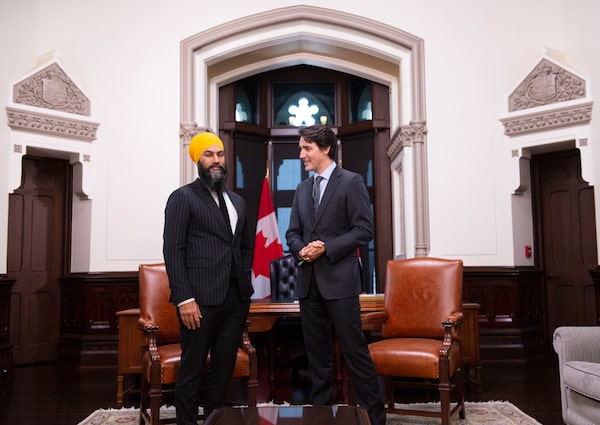
NDP leader Jagmeet Singh meets with Prime Minister Justin Trudeau on Parliament Hill on Nov. 14, 2019.Sean Kilpatrick/The Canadian Press
Update: The details of the agreement reported below have been announced by Prime Minister Justrin Trudeau.
The Liberal government has reached an informal deal with the NDP to stay in power until 2025, in exchange for a pledge to act on dental care, pharmacare and other key issues advocated by New Democrats, sources say.
The deal, which is tentative and still requires the approval of the NDP caucus, would not give the New Democrats any cabinet seats, according to two sources.
The Globe and Mail is not identifying the sources because they were not authorized to discuss the matter publicly.
Paul Wells: With his deal with the NDP, Justin Trudeau gets to go back to sunny ways
Lori Turnbull: The Liberal-NDP deal is all about politics, not policy – for both sides
Explainer: What is the Liberal-NDP deal? The supply-and-confidence agreement explained
Prime Minister Justin Trudeau convened an unannounced special cabinet meeting late Monday evening, followed by a hastily scheduled private briefing to the Liberal caucus.
The Prime Minister has scheduled a 9 a.m. news conference to announce the deal and will fly later tonight to the special NATO summit being held in Brussels on March 24.
An NDP source said party leader Jagmeet will confirm the deal at his morning news conference. The source said the agreement contains pledges to offer an income-based dental care program, action on pharmacare and housing, as well as other policy areas. The Globe is not identifying the NDP source, who was not authorized to discuss the deal before it is publicly announced.
A senior government official said the Liberal-NDP pact is about “delivering stability and results” in an unstable world with increased political polarization. The source said both parties have areas of mutual agreement, citing climate, housing, health and Indigenous reconciliation.” The two parities don’t agree on everything but the source said they can stand together on issues they agree on and for what Canadians voted for. The Globe is not identify the senior official who was not authorized to speak publicly about the deal.
The sources said the agreement-in-principle would require NDP support for the minority government on key confidence matters, including budgets, in exchange for increased parliamentary collaboration on major NDP policy issues. The government is also expected to forge ahead with NDP-supported plans to impose a special tax on Canadian banks and financial institutions, a Liberal promise during the 2021 election campaign.
The cabinet meeting and caucus briefing were not listed on the Prime Minister’s public itinerary when they occurred, even though such details are normally announced publicly. Cabinet ministers and senior staff, including in the Prime Minister’s Office, did not respond to requests to discuss the agreement.
In November, the NDP held informal talks with the Liberals about a potential deal to prop up the minority government for two to three years in exchange for action on housing, pharmacare, climate change, compensation for Indigenous children and other issues.
The deal did not go ahead, but Mr. Singh said at the time that he was open to discussions aimed at making Parliament work.
He told reporters then that no specific offer of a deal to support the Liberals was made during postelection talks with Mr. Trudeau.
The NDP leader said he was open to a loose agreement to support legislation – such as measures to make housing more affordable – on a case-by-case basis.
On Monday, Mr. Singh put forward a motion calling on the government to deliver on the Liberal campaign promise to impose a surtax on banks and insurance companies – and to expand the tax hike to include oil companies, grocery chains and big-box stores.
The Liberal Party’s 2021 election platform included a pledge to raise nearly $11-billion in tax revenue over five years with the new measure. The proposal included a three-percentage-point corporate tax rate increase – from 15 per cent to 18 per cent – on banks and insurance companies with more than $1-billion in profits, and a requirement that these same companies pay a Canada Recovery Dividend.
Liberal MPs did not take a firm position on the NDP motion during Monday’s debate. The House is scheduled to vote on the matter on Tuesday.
Mr. Singh has a news conference scheduled for Tuesday where he plans to talk about how to make life more affordable, given the recent rise in gas and food prices.
At a news conference on Monday, Mr. Singh was directly asked for an update on the status of his party’s prebudget talks with the Liberal government.
Mr. Singh said his party’s priorities are well known. He listed health care, pharmacare, justice for Indigenous people and climate change as areas where the NDP will continue to push for change.
Mr. Singh also said his party does not support the use of back-to-work legislation to resolve a work stoppage at Canadian Pacific Railway Ltd., which entered its second day on Monday.
Several NDP MPs declined to comment Monday evening when contacted by The Globe and Mail. The NDP caucus communications team did not return requests for comment.
Conservative Party interim leader Candice Bergen initially commented on the agreement Monday evening on Twitter, saying: “God help us all.”
She then issued a more detailed statement.
“The NDP-Liberal coalition is nothing more than a callous attempt by Trudeau to hold on to power,” she said. “Canadians did not vote for an NDP government. This is little more than backdoor socialism... With rising inflation, out-of-control cost of living, and national unity at stake, Trudeau knows he is losing the confidence of Canadians.
“His answer is to stay in power at all costs including implementing the even harsher and more extreme policies of the NDP.
“If this NDP-Liberal coalition stands, Canada is in for a very rough ride.”
Although Ms. Bergen used the term “coalition,” the tentative agreement between the Liberals and the NDP would fall short of a formal coalition government because it would not involve NDP MPs sitting in cabinet.
The only formal coalition government at the federal level in Canada was formed in 1917 under Prime Minister Robert Borden, during the First World War.
The current talks between the Liberals and the NDP appear to be inspired by precedents at the provincial level, which have allowed minority governments to continue for periods of time with the support of smaller parties, in exchange for policy concessions.
Examples of this include Ontario’s Liberal minority government, which remained in power from 1985 to 1987, thanks to an agreement with the NDP.
More recently, in British Columbia, the NDP and the Green Party struck a deal following the 2017 provincial election that saw the NDP form a minority government even though the party had two fewer seats than the incumbent Liberals.
That written agreement between the NDP and the Green Party was called a confidence and supply agreement, meaning the Green Party agreed to vote with the government on confidence matters.
About 20 per cent of Canadians, or more than 7.5 million people, are estimated to be either uninsured or underinsured for prescription drug costs. A national pharmacare plan would address that, and aim to save billions of dollars. Globe health reporter Kelly Grant explains.
The Globe and Mail
For subscribers: Get exclusive political news and analysis by signing up for the Politics Briefing.
 Robert Fife
Robert Fife Bill Curry
Bill Curry